How Video Translation Can Grow Your Business?
BUSINESS TIPSTECHNOLOGY TRENDS
River Chan
7/4/202411 min read


For 2024, 91% of businesses are using video as a marketing tool, marking an all-time high since data tracking began in 2016.
This widespread adoption highlights video’s critical role in business communication strategies.
Moreover, 94% of video marketers consider video essential to their digital marketing strategy, with 99% planning to continue using it in the future.
Additionally, the average person will spend over 100 minutes daily watching online videos, showcasing consumers' growing preference for video content.
Therefore video has become the dominant form of communication online, businesses are increasingly recognizing the need to adapt their video content for a global audience.
Video translation became crucial for businesses looking to expand their reach and connect with diverse audiences across different regions, particularly in Asia with other languages by using the same content.
By translating video content into local languages, companies can overcome language barriers, enhance viewer engagement, and build stronger connections with potential customers.
While it is essential to consider cultural backgrounds and tailor content to create genuine resonance, video translation offers a cost-effective alternative for tutorial videos and less creative content, enabling easier and more efficient market expansion.
In this blog, we will explore the process of video translation, its importance for businesses, especially those venturing into Asian markets, and how AI video translation can help facilitate this process.
Summary: The Importance of Video Translation
Video translation has emerged as a powerful tool like verbalate.ai for businesses looking to expand their global reach, particularly in the diverse and rapidly growing Asian markets.
As businesses continue to navigate the complexities of global expansion, video translation stands out as an essential strategy for breaking down language barriers and connecting with diverse audiences.
The advancements in AI video translation tools have made this process more accessible and effective than ever before.
We encourage you to explore the possibilities that video translation offers for your business.
By incorporating video translation into your expansion strategies, you can significantly improve your brand's global presence, engage with new markets more effectively, and create meaningful connections with audiences across Asia and beyond.
Take the first step towards global content success – embrace video translation and unlock the full potential of your business in the international arena.
At ToAsia.biz, we specialize in providing business consultation services to help you navigate and thrive in the Asia Pacific region.
Our growth strategy is unique—focused on helping you expand at the right pace while staying lean and profitable.
Talk to us today and discover how our approach sets us apart from other business consultants.
Let us lead your business to new heights in the Asia Pacific market.


Leveraging AI for Seamless Multilingual Video Translation
Video translation has been revolutionized by the advent of Artificial Intelligence, making it faster, more accurate, and more accessible than ever before.
AI video translation tools like Verbalate.ai, HeyGen, and Wave AI are transforming the landscape of video localization by offering advanced features such as automatic subtitle generation, voice cloning, and lip-syncing.
These technologies leverage machine learning algorithms to analyze speech patterns, facial movements, and linguistic nuances, enabling seamless translation of video content into multiple languages.
AI not only speeds up the translation process but also enhances accuracy, with some platforms boasting up to 98.5% accuracy in subtitle translations.
Furthermore, AI-driven video translation can maintain the original speaker's tone, emotion, and personality, creating a more authentic viewing experience for global audiences.
As AI continues to evolve, it promises to break down language barriers in video content, making information more accessible worldwide and opening up new opportunities for businesses, educators, and content creators to reach diverse international markets.
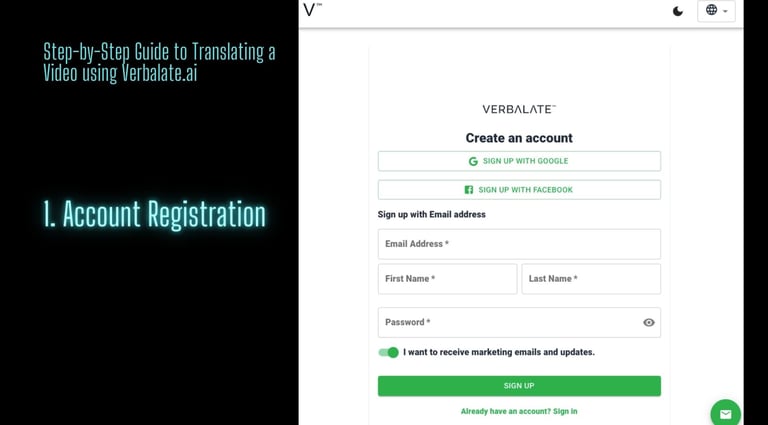

Step-by-Step Guide to Translating a Video using Verbalate.ai
Verbalate.ai offers a comprehensive solution for video translation, including voice cloning and lip sync. Here’s a step-by-step guide to translating a video using Verbalate.ai:
1.Account Registration
Register on the Verbalate.ai website
Click the button "Try for Free"
Create an account via Google, Facebook, or Email
Free demo users can upload videos for up to 1 minute; subscribed users can enjoy extended features, including a voice clone function, multi-language video and audio tracks, lip sync translation, and 2 months free on yearly plans.
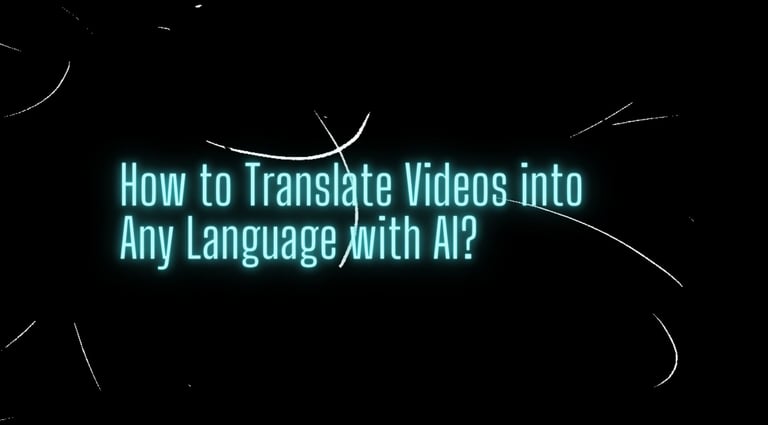

How to Translate Videos into Any Language with AI?
Skip the middleman!
Translate your videos directly without needing a translation house or video editor.
Translating a video has become significantly easier and more accessible with AI-powered tools.
Let's see how can you translate a video using verbalate.ai
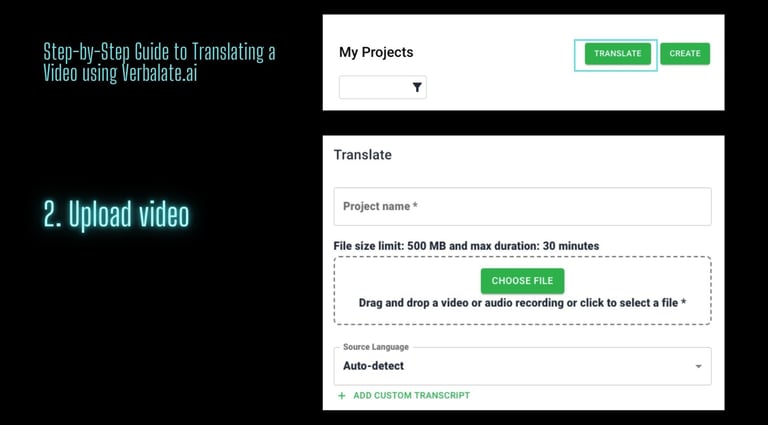

Upload video with basic settings
Click the “translate” button, enter the project name, and upload your video (max 500MB, 30 minutes)
Ensure your video is in .MP4 format for optimal results
Choose the source language (auto-detect or manual)
You can also optionally choose “Add custom Transcript” which is your textual representation of the audio content in a project.
Instead of using automated transcription services, you can upload your transcript file that aligns with your project’s specific needs.
This allows you to customize every word to ensure accuracy and context.
Also, you can use your styles or notes that help you in the editing process.
Please be reminded that single speaker per caption.
Each caption block in your uploaded subtitle file must represent speech from a single speaker only.
Accurate timestamps are crucial for the voice cloning and lip-syncing process to work correctly.
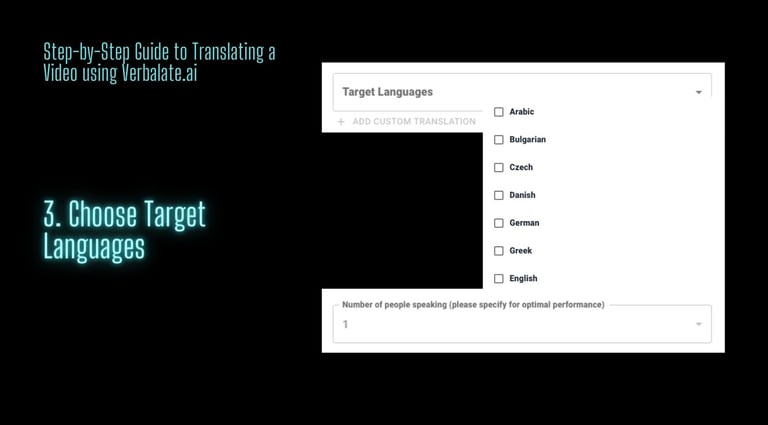

3.Choose Target Languages
Select target languages like Mandarin Chinese, Japanese, or Hindi.
Each language you translate to will consume credits according to your plan. For example, translating a 2-minute English video to both Japanese and Hindi would consume 4 credits total for this project.
Premium users can specify the number of speakers; the default is 1.

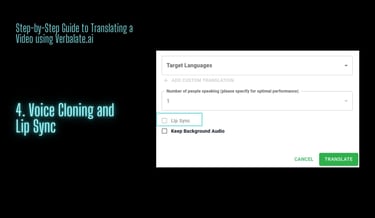
4.Voice Cloning and Lip Sync
Optionally enabling lip sync function.
To achieve the best results with the lip sync function for your output video, ensure the following:
The person on the screen is facing the camera.
Maintain a reasonable distance from the camera.
Only one person is on screen at a time.
Limit head movements for optimal accuracy.
Avoid obscuring your lips with clothing or the microphone.
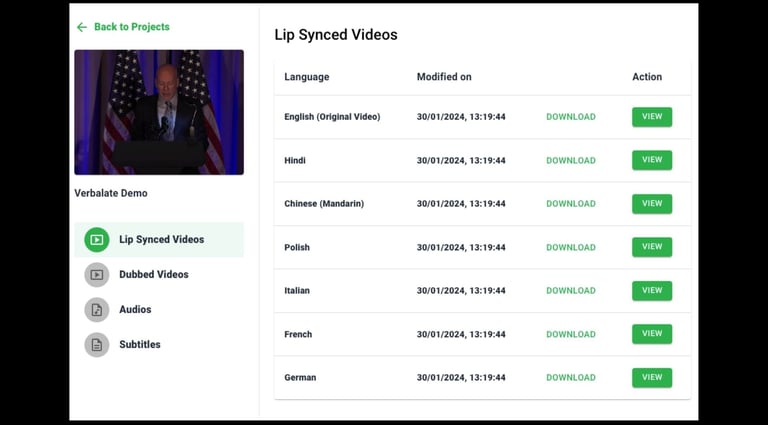

5.Review and Finalize Translated Video
After processing is complete, you'll find all your output videos in your panel.
These can include lip-synced videos (if you selected this option earlier), dubbed videos, audio-only files, and subtitle files.
Clicking on any of these options will allow you to view or download the corresponding videos in different languages.
Remember to review the translated videos for accuracy and make any necessary adjustments.
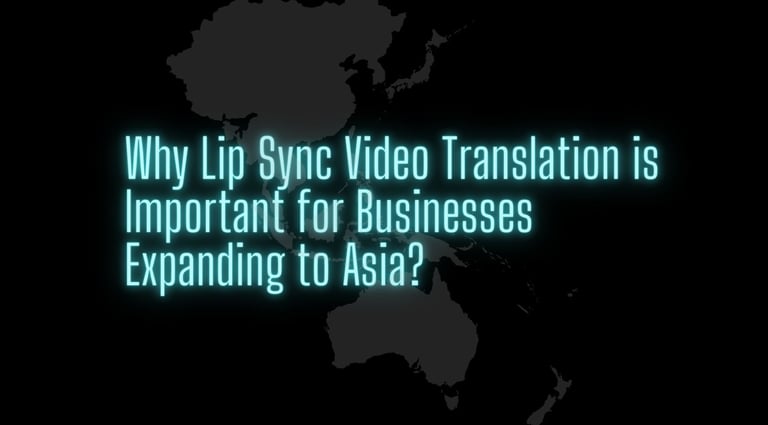

Why Lip Sync Video Translation is Important for Businesses Expanding to Asia?
Lip sync technology plays a crucial role for businesses expanding into Asian markets, offering significant advantages in content localization and audience engagement.
The importance of lip sync in this context cannot be overstated, as it directly impacts how effectively a company can communicate with and appeal to diverse Asian audiences.
Firstly, lip sync technology enhances the authenticity of translated content, making it appear as if the speaker is naturally communicating in the target language.
This is particularly important in Asian cultures where nuanced communication and personal connection are highly valued.
When viewers see content that appears to be originally created in their language, it fosters a sense of trust and relatability.
Moreover, proper lip sync is a key component of effective localization strategies.
It goes beyond mere translation, adapting content to resonate deeply with local audiences.
In Asia, where cultural sensitivity and local relevance are paramount, lip-synced videos can make viewers feel that the content was specifically tailored for them.
This perception can lead to improved brand perception and increased customer loyalty.
In the highly competitive Asian markets, where consumers are inundated with both local and international content, high-quality lip-synced videos provide businesses with a distinct competitive edge.
They stand out from poorly localized or non-localized content, attracting more viewers and potential customers.
This is particularly important in countries like China, Japan, and South Korea, where consumers have high expectations for production quality and local relevance.
Furthermore, lip sync technology aligns well with the growing trend of video consumption in Asia.
With the region's high smartphone penetration and increasing internet speeds, video has become a dominant form of content consumption.
By 2024, it's estimated that the average person will spend over 100 minutes daily watching online videos, a trend particularly pronounced in Asian markets.
Businesses that leverage lip sync technology to create engaging, localized video content are better positioned to capture a share of this growing audience.
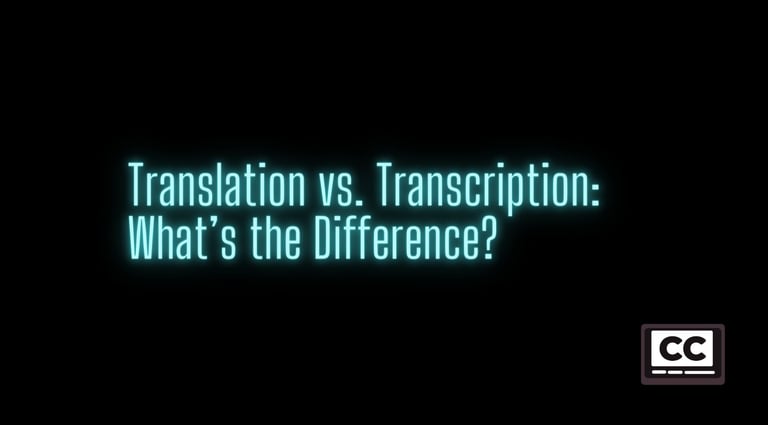

Translation vs. Transcription: What’s the Difference?
Understanding the distinction between translation and transcription is crucial for businesses and content creators aiming to effectively localize their video content.
While both processes involve converting information from one form to another, they serve different purposes and are applied in distinct contexts.
Translation is the process of converting spoken or written content from one language to another while preserving the original meaning.
In the context of video localization, translation is essential for creating multilingual content that can reach global audiences.
It involves not just converting words, but also adapting cultural references, idioms, and context to ensure the message resonates with the target audience.
Translation is used in creating subtitles in different languages, dubbing videos with voice-overs in target languages, and localizing on-screen text or graphics.
The primary goal of translation in video content is to break down language barriers and make the content accessible and engaging for international audiences.
Translation is ideal for businesses looking to expand their reach to global audiences.
It's essential for international marketing campaigns, e-learning platforms targeting multiple countries, and global customer support services.
Translation enables companies to communicate their message effectively across different linguistic and cultural contexts, crucial for building a global brand presence.
On the other hand, transcription is the process of converting spoken language into written text within the same language.
This doesn't involve changing the language but rather creating a textual record of spoken words.
In video production, transcription is commonly used to create captions or subtitles in the original language of the video.
This is particularly useful for enhancing accessibility for deaf or hard-of-hearing viewers, improving SEO for video content, and creating written records that can be easily searched or referenced.
For example, a lecture video in English would be transcribed into English text, allowing viewers to read along or review the content later.
Transcription is also valuable for documentation purposes, such as creating written records of interviews or speeches, and for content analysis, where researchers or marketers might want to analyze the text of spoken content. The applications of these two processes differ significantly.
Transcription, while not breaking language barriers like translation, has its own set of valuable applications.
It's indispensable for making content accessible to people with hearing impairments, complying with accessibility regulations in many countries.
Transcription also enhances the searchability of video content, improving its discoverability on search engines and within video platforms.
In academic or business settings, transcriptions of lectures, meetings, or interviews provide valuable written records for future reference or analysis.
In the context of video localization, both translation and transcription often work in tandem.
Understanding the distinct roles and applications of translation and transcription allows content creators and businesses to develop comprehensive strategies for making their video content accessible, engaging, and effective across diverse global audiences.
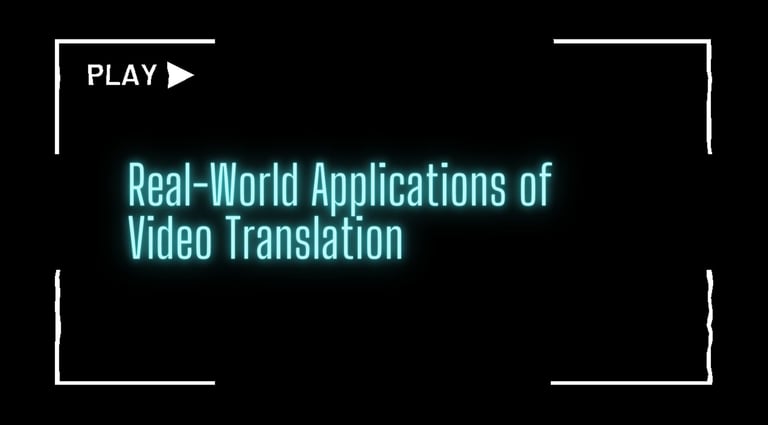

Real-World Applications of Video Translation
Real-world applications of video translation have demonstrated significant benefits across various industries, showcasing the technology's potential to expand global reach and enhance audience engagement.
E-Learning Platforms have leveraged video translation tools to dramatically expand their global user base.
Coursera, a leading online education provider, used AI-powered video translation to offer courses in multiple languages.
The translations cover the full in-course experience: lecture video subtitles, course readings, quizzes, assessments, assignments, instructions, discussion prompts, course descriptions, and syllabi.
Offering content in learners' native languages not only increased enrollment but also because students could better understand and engage with the material.
Another example is Netflix uses AI-powered translation and localization to dub, lip sync and translate content into multiple languages, including subtitles and voiceovers.
In Customer Support, multinational companies have significantly improved their service quality and customer satisfaction by translating support videos, product tutorials and troubleshooting guides.
The success of these applications underscores the transformative potential of video translation technology in breaking down language barriers and creating more inclusive, engaging, and effective global communication strategies.
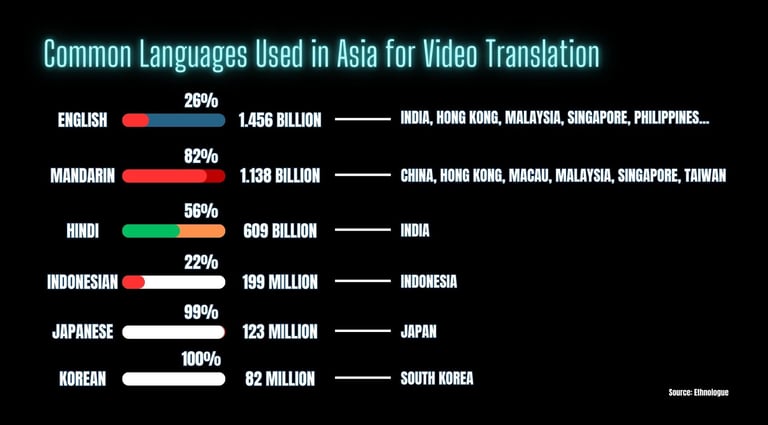

Common Languages Used in Asia for Video Translation
When expanding into Asia through video translation, it's crucial to consider the most widely spoken languages to maximize reach and impact.
Here's a detailed look at the common languages used for video translation in Asia:
Mandarin Chinese is the most spoken language in the world and is essential for reaching audiences in mainland China.
With over 1 billion speakers, Mandarin is the official language of China and is also widely used in Singapore and Taiwan.
For businesses targeting the vast Chinese market, Mandarin translation is indispensable.
It's worth noting that Mandarin uses simplified Chinese characters in mainland China and Singapore, while traditional characters are used in Taiwan.
Cantonese, although less widely spoken than Mandarin, is crucial for reaching audiences in Hong Kong, Macau, and parts of Guangdong province in China.
With approximately 80 million speakers, Cantonese is known for its complex tonal system and unique vocabulary.
Videos targeting these regions should consider Cantonese translation to effectively engage local audiences.
When considering video translation for Asian markets, it's also important to note the distinction between simplified and traditional Chinese characters.
Simplified Chinese is used in mainland China, Singapore and Malaysia, while traditional Chinese is preferred in Hong Kong, Macau, and Taiwan.
This distinction is crucial for written content in videos, such as subtitles or on-screen text.
Hindi is widely spoken in India, one of the world's fastest-growing markets.
With about 500 million speakers, Hindi serves as a lingua franca across much of northern and central India.
As India's digital consumption continues to rise, Hindi video content is becoming increasingly important for businesses looking to tap into this diverse and expansive market.
Japanese is essential for businesses targeting Japan, a country known for its high consumer spending and technological advancement.
With 126 million native speakers, Japanese is crucial for reaching this sophisticated market.
Japanese consumers are known for their preference for high-quality, localized content, making accurate and culturally appropriate video translation vital.
Korean has gained significant importance in recent years, largely due to South Korea's growing cultural and economic influence.
With 77 million speakers worldwide, Korean is key for reaching the tech-savvy and trend-setting South Korean market.
The global popularity of Korean entertainment has also increased the demand for Korean-language content across Asia and beyond.
Malay/Indonesian is useful for engaging audiences in Malaysia, Indonesia, and parts of Singapore.
Indonesian, a standardized form of Malay, is spoken by over 200 million people, making it a crucial language for reaching Southeast Asian markets.
These countries represent significant economic opportunities, with rapidly growing digital and consumer markets.
By focusing on these key languages, businesses can effectively localize their video content to reach a vast and diverse Asian audience.
Each language represents unique cultural nuances and market opportunities, making thoughtful and accurate translation essential for success in Asia's dynamic and growing markets.


River Chan is a marketing director of ToAsia.biz with over 10 years of experience in marketing from strategic planning, project execution, and data analysis across different industries.
About Author
Copyright © 2025 ToAsia.biz


We lead your business to Asia
Our Business Growth Experts help SaaS businesses achieve growth in Asia and become profitable FAST.
Send us a message via WhatsApp
